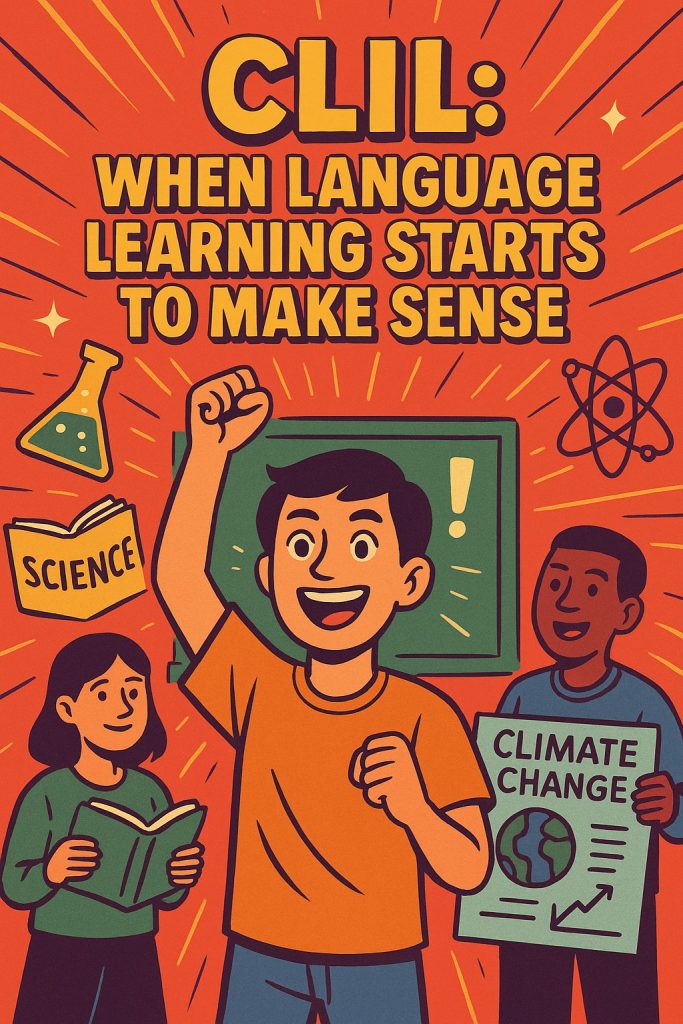
One of the biggest reasons teachers and schools turn to CLIL (Content and Language Integrated Learning) is simple: it makes students want to learn. So often, traditional language lessons feel dry because they treat language like a puzzle of rules to memorize. But in real life, language is a living tool—it helps us explain, ask questions, work with others. CLIL brings that to the classroom.
In a CLIL class, students don’t study grammar just because it’s in the syllabus. They use the language to do real things: to understand a science experiment, to debate a history topic, or to put together a group project. When students see a clear reason to use the language, they start to care. They realize, “If I can say this well, I can understand the topic better—and show what I know.”
Purpose is everything when it comes to motivation. Nobody likes doing tasks that feel pointless. However, when students write a report about an experiment they conduct in English or explain how a chemical reaction works, the language has a purpose. It isn’t empty practice; it’s a bridge to ideas that matter. That feeling—that what they’re learning is useful—keeps students interested.
Another nice thing about CLIL is that it gives students different ways to shine. Some kids feel more confident about the content, while others are stronger in language skills. In an integrated class, they can help each other and grow in both areas. A student who struggles with English but knows the science well might feel proud explaining an idea. That small success can boost their confidence to try more.
CLIL lessons also look and feel different from the old-school “sit and listen” style. Instead of just lectures or worksheets, students work together, ask questions, and do projects. They learn to solve problems in teams, to negotiate meaning, to teach each other. That energy in the room makes them more active and less afraid of making mistakes. They learn not just from the teacher, but from each other too.
Giving students a sense of control is another motivator. Good CLIL teachers know that real learning happens when students take charge. They might research a topic, prepare a presentation, or reflect on what language they need next time. That small piece of ownership helps them feel like their learning is theirs—not just something handed to them.
For students from different cultures and language backgrounds, CLIL can be even more meaningful. It reminds them that their language skills are powerful, not a barrier. They see how speaking more than one language connects them to new ideas, people, and places. It can even help them feel proud of their identities and excited about the doors that open when they learn to communicate well in more than one language.
Of course, none of this happens overnight. Motivation doesn’t magically appear just because a lesson uses CLIL. The topics have to be interesting and clear. Teachers need to break down big ideas into steps, so nobody feels lost. If the language or the content is too hard, students can shut down. The balance between challenge and support is key.
But when it’s done right, CLIL turns language learning into something real. Students stop asking, “Why do I need this?”—because the answer is right there in front of them. They need it to talk about the world, share what they know, and learn from each other. That’s how motivation grows: not through drills and memorization, but through doing something that matters.
In the end, motivated students don’t just pass tests. They become curious, confident communicators. They see learning as something that keeps going, long after they leave the classroom. And that’s what every teacher really wants—to see students excited to learn, not just today, but for life.
Dr. Humeyra Turedi
References
- Deci, E. L., & Ryan, R. M. (2000). The “what” and “why” of goal pursuits: Human needs and the self-determination of behavior. Psychological Inquiry, 11(4), 227–268.
- Coyle, D., Hood, P., & Marsh, D. (2010). CLIL: Content and Language Integrated Learning. Cambridge University Press.
- Lasagabaster, D., & Doiz, A. (2016). CLIL students’ perceptions of their language learning process: A longitudinal study. Language Teaching Research, 20(6), 668–688.
- Mehisto, P., Marsh, D., & Frigols, M. J. (2008). Uncovering CLIL. Macmillan Education.
- Dörnyei, Z. (2001). Motivational Strategies in the Language Classroom. Cambridge University Press.
CLIL ve Öğrenci Motivasyonu: Öğrenmeyi Anlamlı Kılmak
Dr. Hümeyra Türedi
Öğretmenlerin ve okulların CLIL’i (İçerik ve Dil Bütünleştirmeli Öğrenim) tercih etmesinin en büyük nedenlerinden biri oldukça basit: Öğrencilerin gerçekten öğrenmek istemelerini sağlar. Geleneksel dil dersleri çoğu zaman kuru ve sıkıcı gelir çünkü dili ezberlenmesi gereken kurallar yığını olarak sunar. Oysa gerçek hayatta dil canlı bir araçtır — açıklamak, soru sormak, başkalarıyla iş birliği yapmak için kullanılır. CLIL, dili sınıfa bu haliyle getirir.
Bir CLIL dersinde öğrenciler dilbilgisini yalnızca müfredatta olduğu için öğrenmez. Dili gerçekten bir şey yapmak için kullanırlar: Bir fen deneyini anlamak, tarih konularını tartışmak ya da bir grup projesini tamamlamak gibi. Öğrenciler dili kullanmak için somut bir neden gördüklerinde, sürece daha çok önem verirler. Şunu fark ederler: “Eğer bunu düzgün ifade edebilirsem, konuyu daha iyi anlayabilirim — ve ne bildiğimi gösterebilirim.”
Motivasyon söz konusu olduğunda amaç her şeydir. Kimse anlamsız görünen bir işi yapmak istemez. Oysa öğrenciler İngilizce olarak yaptıkları bir deney hakkında bir rapor yazdıklarında ya da bir kimyasal tepkimeyi açıklamak zorunda kaldıklarında, dil bir amaca hizmet eder. Boş bir alıştırma değildir; anlamlı fikirlere ulaşmak için kurulan bir köprüdür. Öğrendiklerinin işe yaradığını hissetmek, onları sürece bağlı kılar.
CLIL’in güzel yanlarından biri de öğrencilere parlayabilecekleri farklı alanlar sunmasıdır. Bazı öğrenciler içerik konusunda güçlüdür, bazıları ise dil becerilerinde daha iyidir. Entegre bir derste bu öğrenciler birbirlerine yardımcı olur ve her iki alanda birlikte gelişirler. İngilizce konusunda zorlansa da bilimsel içeriği iyi anlayan bir öğrenci, bir fikri başarıyla açıkladığında kendisiyle gurur duyar. Bu küçük başarılar daha fazlasını deneme cesareti verir.
CLIL dersleri, eski usul “otur ve dinle” derslerinden çok daha farklıdır. Sadece ders anlatımı ya da alıştırma kağıtları yerine, öğrenciler birlikte çalışır, soru sorar ve projeler hazırlar. Takım çalışması içinde sorun çözmeyi, anlamı müzakere etmeyi ve birbirlerine öğretmeyi öğrenirler. Bu sınıf enerjisi onları daha aktif kılar, hata yapmaktan korkmaz hale getirir. Öğrenmeyi sadece öğretmenden değil, birbirlerinden de sağlarlar.
Öğrencilere kontrol hissi vermek de motivasyonu artıran başka bir unsurdur. İyi bir CLIL öğretmeni gerçek öğrenmenin öğrencinin sürece sahip çıkmasıyla başladığını bilir. Öğrenciler bir konuyu araştırabilir, sunum hazırlayabilir ya da bir sonraki derste ihtiyaç duyacakları dil üzerine düşünebilir. Bu küçük sahiplenme duygusu, öğrenmenin yalnızca dışarıdan verilen bir şey değil, onlara ait bir süreç olduğunu hissettirir.
Farklı kültür ve dil geçmişlerinden gelen öğrenciler için CLIL çok daha anlamlı olabilir. Bu yöntem onlara dil becerilerinin bir engel değil, bir güç olduğunu hatırlatır. Birden fazla dil konuşmanın onları yeni fikirlere, insanlara ve yerlere bağladığını görürler. Hatta bu durum, kimlikleriyle gurur duymalarına ve birden fazla dilde iyi iletişim kurmanın açabileceği kapılara heyecanla bakmalarına yardımcı olabilir.
Elbette bunların hiçbiri bir anda gerçekleşmez. Motivasyon, sırf bir ders CLIL yöntemiyle işlendi diye sihirli biçimde ortaya çıkmaz. Konuların ilgi çekici ve anlaşılır olması gerekir. Öğretmenlerin büyük fikirleri adım adım açıklaması, kimsenin geride kalmamasını sağlaması gerekir. Dil ya da içerik çok zor olursa öğrenciler motivasyonlarını kaybedebilir. Bu yüzden, zorluk ile destek arasında denge kurmak esastır.
Ancak CLIL doğru uygulandığında, dil öğrenimini gerçek bir sürece dönüştürür. Öğrenciler “Bunu neden öğreniyorum ki?” diye sormazlar — çünkü cevap gözlerinin önündedir. Dünyayı konuşabilmek, ne bildiklerini ifade edebilmek ve başkalarından öğrenebilmek için bu dile ihtiyaçları vardır. İşte bu şekilde motivasyon gelişir: Ezberle ve tekrar et yerine, anlamlı bir şey yaparak.
Sonuçta, motive olmuş öğrenciler yalnızca sınavları geçmekle kalmaz. Meraklı, kendine güvenen iletişimciler hâline gelirler. Öğrenmeyi sınıfla sınırlı bir görev değil, ömür boyu sürecek bir yolculuk olarak görürler. Ve bu da her öğretmenin en büyük arzusu değil midir — öğrencilerini yalnızca bugün değil, tüm hayatları boyunca öğrenmeye hevesli görmek?
Kaynakça
Deci, E. L., & Ryan, R. M. (2000). The “what” and “why” of goal pursuits: Human needs and the self-determination of behavior. Psychological Inquiry, 11(4), 227–268.
Coyle, D., Hood, P., & Marsh, D. (2010). CLIL: Content and Language Integrated Learning. Cambridge University Press.
Lasagabaster, D., & Doiz, A. (2016). CLIL students’ perceptions of their language learning process: A longitudinal study. Language Teaching Research, 20(6), 668–688.
Mehisto, P., Marsh, D., & Frigols, M. J. (2008). Uncovering CLIL. Macmillan Education.
Dörnyei, Z. (2001). Motivational Strategies in the Language Classroom. Cambridge University Press.



